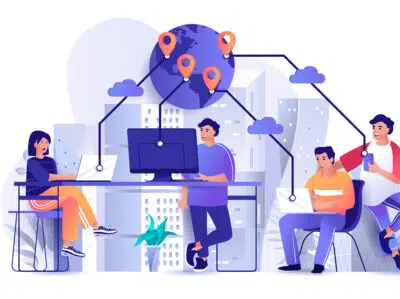Walking the talk on diversity and inclusion in the workplace

The ultimate guide to employer branding
March 15, 2022
9 ways to build a talent pool
March 17, 2022
Inclusion in work, business team concept. Handsome male coworker on wheelchair with his creative business colleagues in meeting room at creative office, smiling, looking at camera, hugging each other.
It’s been some decades now since the buzzwords diversity and inclusion have been . . . well . . . buzzing around in workplaces worldwide. How and why did D&I become a critical aspect of business strategy? And importantly, how can Indian businesses walk the talk on diversity and inclusion?

But first, here’s a brief timeline on the evolution of diversity and inclusion in the working world:
1940 - 1960s:
- U. S. President Truman signed the Executive Order 9981 to desegregate the US Army – the world’s first legislation to formalize workplace diversity.
- American civil rights movements further opened up the workplace to varied ethnic and cultural groups.
- More anti-discrimination legislations introduced: Equal Pay Act (1963), Title VII of the Civil Rights Act (1964) and Age Discrimination in Employment Act (1967).
1980s through the early 2000s:
Gender diversity initiatives drove up the number of women in the workforce.
2010 - composition of US workforce:
White non-Hispanics: 60%
Hispanic: 17%
African-American: 12%
Foreign-born immigrants, including Asians: 17%
- Diversity at an all-time high.
- Businesses scale new peaks in terms of technological advances and innovation.
- The world realizes: a diverse workforce is also a more productive workforce.
2000s–2015:
- Millennials entered the workforce with different expectations of employers.
- Inclusion programmes gained traction.
- Research conducted on unconscious bias and its impact on inclusion.
- From an IIMA (2015) report: Diversity is “an imperative that organisations can no longer choose to ignore.”
2015 to the present-day:
- A third element added to the discourse on diversity and inclusion — equity, originating from the demand for gender-based equal pay.
- In the US, Gen Z with a large non-white component entered the workforce — an idealistic cohort seeking employment with firms that positively impact society.
Since the initial focus on women and people of colour, the meaning of diversity has expanded to include other forms of demographics such as religious practices and sexual orientation (Diversity and Inclusion at the Workplace: A Review of Research and Perspectives by Nisha Nair & Neharika Vohra – IIMA 2015) |
|---|
Defining diversity and inclusion
Diversity typically focuses on the differences and demographic make-up of groups or organisations. So what’s inclusion? The processes that actually make diversity work; in other words, engaging employees from diverse backgrounds and enabling their participation so that they may use their talents to the fullest in their organisation.

Importantly, from a worker’s perspective, an insightful definition of inclusion would be “the degree to which an employee perceives that he or she is an esteemed member of the work group through experiencing treatment that satisfies his or her needs for belongingness and uniqueness.” (Diversity and Inclusion at the Workplace: A Review of Research and Perspectives by Nisha Nair & Neharika Vohra )
How D&I benefits organisations
Apart from societal expectations on diversity, there’s plenty of proof available now that D&I programmes have produced solid, verifiable benefits for organisations that have incorporated these concepts in their DNA.
In 2015, a McKinsey report revealed that American companies with the highest levels of racial and ethnic diversity were more likely to post profits above industry standards. The report stated that diversity has been shown to impact an organisation’s performance in multiple ways. For example:
- Advantage in attracting talent. Organisations that consider varied aspects of diversity, including gender, ethnic background, age etc., help to significantly widen the available talent pool, and may help to bring down costs of hiring.
- Higher employee satisfaction. The McKinsey survey revealed that employee satisfaction levels remain static in firms where D&I programmes are superficially implemented. Where genuine workplace diversity and inclusiveness were present, women and minority group employees expressed an enhanced level of career and personal satisfaction. Other studies revealed a host of positive outcomes related to inclusive work environments: employees’ organisational commitment, intent to stay, creativity and enhanced career opportunities.
- Better decision-making, more innovation. The more diversity in a workplace, the more diverse is the output of solutions, ideation and creativity.
- Greater brand value. Focusing on D&I boosts the organisation’s brand value, leading to better attraction and retention of talent.
A survey of Indian organisations says that employees who felt included accounted for 43 per cent of team citizenship behaviour. (The Economic Times)
Diversity hiring in India
How much does D&I figure in Indian business? Comme ci, comme ca, as the French would say. Data from surveys indicate that while diversity talent pool creation in India is still defined primarily from a gender perspective, namely, ramping up female participation, there is “an increasing focus on dimensions of workforce diversity including diversity of sexual orientation, PwDs and generational diversity.”
Notwithstanding this somewhat patchy progress, it’s important to appreciate that there’s no one-size-fits-all strategy for D&I programmes. The extent of diversity, and its importance, varies vastly across cultures. However, Indian business leaders, belonging to one of the world’s most diverse nations, are naturally equipped to leverage this advantage. Businesses seeking to ramp up their D&I recruitment strategies can make a start by examining how exclusion works locally. Typically, in South Asian countries, exclusion runs along the faultlines of gender, caste, clan, religion, language, and income levels, among others. Before initiating D&I programmes, it's essential for an organisation to look at these issues closely through a local lens and understand how exclusion/inclusion is defined within their specific regions.
Walking the talk on D&I
This brings us to some broad goals and best practices that organisations can embrace to promote diversity and develop an inclusive environment:

Understanding today’s environment
Set up a process to understand what’s going on currently inside the organisation. Some examples:
- Collect data on demographics, performance, salaries and customer feedback. Analyse the information to detect and remove bias and increase opportunity.
- Regularly share information on the company’s diversity with employees.
- Developing inspirational diversity hiring strategies
Create a D&I vision and strategy that is centred around today’s realities and the potential for the future. Some examples:
- Highlight D&I as a priority to drive business performance.
- Publicly communicate the organisation’s progress towards goals.
- Leadership role in D&I
Managing diversity alone does not necessarily translate into greater productivity and performance. An inclusive workplace must have strongly supportive leaders and empowered employees across all identity groups. Some ideas on how organisations can develop leadership engagement in D&I:
- Regularly integrating communications on D&I within broader discussions on business strategies and results
- Making leaders feel accountable for D&I results
- Involving senior leaders and the Board of Directors to oversee D&I initiatives
- Sustaining D&I
To be effective and enduring, D&I policies should be ingrained into every element of the business. Here are a few recommendations that could help implementation:
- Prioritise diversity in hiring policies, training and supply chain operations.
- Define diversity along broad parameters that focus on the inclusion of a range of differences.
Some specific programmes to promote inclusivity in organisations:
- Employee Resource Groups. ERGs or Focus Discussion Groups (FDGs) enable employees to engage with others and share their expectations and varied concerns. Gender inclusion being a priority, Indian companies have typically focused on their women employees when creating ERGs. The time is now ripe for widening the scope of this tool to include other social groups.
- Back to work programmes. Women wishing to resume their careers after a break—typically availed for childcare, eldercare or other family commitments—often come up against entrenched biases on the lines of having outdated skills or a lack of drive. Since the early 2000s, however, with the clear benefits of diversity hiring in view, Wall Street biggies like Goldman Sachs, consumer food products company Sara Lee and P&G and tech giants HP, Oracle, Dell, Amazon, IBM, Google and Accenture, to name just a few, have recognised that mid-career female employees are “educated, have great work experience, offer mature professionalism and are at a relatively stable stage in life”. They have implemented back-to-work programmes.
- Mentoring programmes. Career development opportunities, implemented through mentoring programmes and training for all employees, can help build an inclusive environment among leaders and diverse employee groups.
- Learning interventions. Pushing back societal biases and sustaining a workplace culture that embraces diversity and inclusion requires long-term effort. Organisations looking to enhance their D&I initiatives can take a leaf out of programme topics that are relevant to the Indian context, such as overcoming unintentional bias, identifying micro-exclusions and training D&I champions. Programmes that expressly highlight the business benefits of diversity and inclusion are also crucial to the effort.
- Inclusive infrastructure. An inclusive workplace should be designed so as not to segregate employees with special needs or focus attention on them. Office design that has a pleasant, inclusive layout makes for a calm yet enlivening atmosphere and therefore, a more productive and creative workplace.
A cautionary note — diversity without inclusion does more harm than good
Diversity and inclusion aren’t magic mantras. An insincere approach and superficial implementation could, in fact, produce contrary results by increasing, rather than reducing, bias.
A Harvard Business Review report from 2016 says that, in a study of 829 American firms, the standard tools of diversity training — hiring tests, performance ratings and grievance systems — were shown to decrease the numbers of women and minorities in managerial positions. These programmes, intended primarily to ward off lawsuits, were implemented through policing business leaders’ performance on D&I parameters. The conclusion? A forceful, top-down approach to incorporating D&I strategies actually worsens bias and feeds rebellion among managers.
DEI (Diversity, Equity & Inclusion) cannot be a programme or an HR initiative. It has to be top of mind for everyone, at every organisational level, and a lens through which business decisions are made. When that happens, DEI stays visible, adapts in alignment with the business, and shifts as the organisational culture morphs over time. - Stacey Williams (Diversity, Equity and Inclusion Professional) writing on LinkedIn |
|---|
Over the years, social science has shown that people tend to push back when rules are forced upon them. It’s their way of asserting autonomy. Organisations can achieve better results with a more sensitive approach, for example, by encouraging voluntary training, engaging leaders in problem-solving and increasing on-the-job interactions with women and minority group employees. Another “soft” strategy that works is promoting social accountability, tapping an individual’s need to appear fair-minded.
A McKinsey study of organisations in 2020 found that “a systematic business approach to I&D, and bold action on inclusion” were critical factors. More specifically, the report advocates approaching I&D with “a robust business case tailored to the needs of individual companies, evidence-based targets, and core-business leadership accountability.”
Careernet helps employers attract diverse talent with carefully planned D&I strategies, hiring systems, and events. To promote workplace inclusion, we offer sensitisation/awareness programmes. Our infrastructure audit services enable the creation of inclusive workplaces for persons with disabilities.
To explore our diversity and inclusion solutions, contact us at sales@careernet.in


